UP Board Class 10 Biology Notes For Heredity
Why do individuals produced after the sexual process, have similar designs?
- Heredity is the study of the transmission of genetic characteristics from parents to offspring and the laws governing such a transmission.
- Along with genetic characteristics, variations also appear during the transmission.
- The branch of biology that deals with the study of heredity and variations is called genetics. The term was coined by Bateson (1906).
heredity and evolution
UP Board Class 10 Biology Notes For Heredity Inherited Traits
Inherited traits are features that an organism receives from its parents through their genes, for example, free ear lobes, attached ear lobes, roller tongue, non-roller tongue, black hair, blonde hair, blue eyes, dimpled and non-dimpled cheeks, and thick and thin lips. The varied expression of so many trials is the reason for such a large number of variations in the same population.
Attached and Free Ear Lobes
Observe The Ear Lobes Of Your Classmates. Note That The Majority Of Them Have Free Ear Lobes. Classmates With Attached Ear Lobes Are Fewer In Number. Record The Ear Lobes Of The Parents Of Your Classmates. Again More Parents Have Free Ear Lobes.
If Both Parents Have Attached Ear Lobes, Their Child Will Also Have Attached Ear Lobes. In Other Cases, Inheritance Depends Upon The Genetic Nature Of The Parents And The Dominance Of Free Ear Lobes Over The Traits Of Attached Ear Lobes.
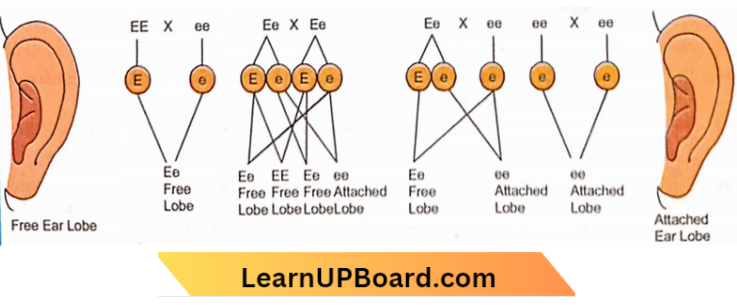
UP Board Class 10 Biology Notes For Heredity Rules For The Inheritance Of Traits—Mendel’s Contributions A
What will be the trait seen in a child, when both the father and mother contribute an equal amount of genetic material (DNA)?
As found out in the inheritance of the trait of ear lobes, both mother and father contribute an equal amount of genetic material to the child.
It means that the child receives two versions of the trait, one from each parent. The expression of the trait in the child depends upon the nature of the traits contributed by the parents. The rules of such inheritance were worked out by Mendel in the 19th century.
Mendel—The Father Of Genetics

Gregor Johann Mendel (1822-1884) found out the mechanism of the passage of traits from one generation to the next and so on. Because of this discovery, he is known as the father of genetics.
- Mendel was born to a farmer’s family in the village of Silesian (now part of the Czech Republic). After graduating he joined a monastery in Brunn (then Austria now Bruno of the Czech Republic) in 1843. He became a priest there in 1847.
- In 1851 Mendel went to Vienna to study science and mathematics. He returned as a substitute teacher as he failed to clear the certificate course for teaching.
- In 1856, Mendel became interested in hybridization experiments on Garden Pea (Pisum sativum) which had several contrasting traits.
- He first raised pure breeding plants and then selected seven characters that had two alternate traits for breeding.
- He read out the results of his experiments in two sittings of Natural History of Brunn in 1865. The same was published as “Experiments on Plant Hybridization” in the proceeding of the society in 1866.
However, Mendel’s work remained unnoticed till similar results were obtained by three scientists independently in 1900—de Vries of Holland, Carl Correns of Germany, and Tschermak Seysenegg of Austria. Mendel’s original paper was found out and republished in Florida in 1901.
heredity notes
Mendel’s Experimental Material
Mendel selected Pea Plant (Pisum sativum) as experimental material because :
- It occupies a small space.
- It has a short life span and annual nature.
- Presence of easily detectable contrasting traits.
- Formation of a large number of seeds.
- It has a flower structure that enables cross-pollination but is normally self-pollinated.
- The plant requires little aftercare.
Seven Characters with Contrasting Limits Selected by Mendel
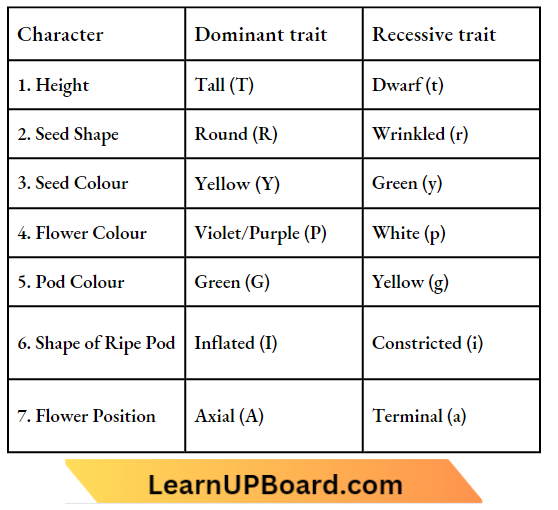
Mendel’S Experiments
Mendel made reciprocal crosses between plants having alternate traits like tall and dwarf, round seeded and wrinkled seeded.
He emasculated (removed anthers) of 50% of the plants of each type and used them as female parents. Pollen for other traits was collected and dusted over their stigmas. Flowers were kept covered with paper and thus obtained were hybrid and constitute tblS CF0SS Were collected and sown next year.
The plants thus obtained were hybrid and F1 or first filial generation. The hybrids were not intermediate between the traits but belonged to one of them. The expressed trait is called dominant while the other unexpressed one is called recessive.
Mendel allowed the F1 plants to self-breed. He obtained F2 generation which had both types of plants, dominant 75% and recessive 25%. Mendel further self-bred F2 plants and obtained F3 generation.
The recessive trait individuals produced recessive trait offspring. One-third of the dominant trait plants formed only dominant offspring while 2/3 behaved like the hybrids giving rise to both dominant and recessive trait offspring in the ratio of 3: 1.
Such a ratio comes to 1 pure dominant, 2 hybrid dominant, and 1 pure recessive. It is called the genotypic ratio.
Monohybrid Cross: Mendel studied the inheritance of two traits of a character at one time through cross-breeding and then self-breeding. It is called a monohybrid cross.
In a cross between pure tall and pure dwarf Pea plants, Mendel obtained only tall plants in the F1 generation. On self-pollination of F1 plants, the F2 generation had both tall and dwarf plants in the ratio of 3: 1.
It is called the monohybrid ratio. The occurrence of dwarf plants in the F2 generation is possible only if the trait of dwarfness is present in the F1 generation but remains unexpressed due to its recessiveness.
Mendel, therefore, proposed that each individual carried two factors for a character. They separate randomly at the time of gamete formation and come together randomly at the time of fertilization.
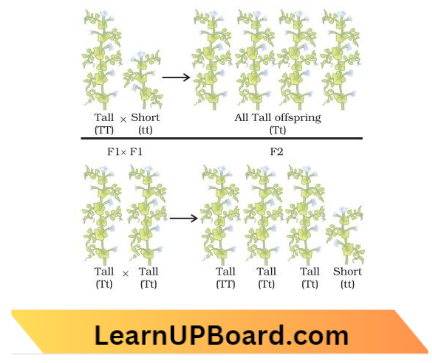
10th heredity and evolution class 10 notes
Work out the Dominant and Recessive Trait
It is a cross between purple-flowered plants with white-flowered plants. The hybrid or F1 plant is purple-flowered though it has received the factor for white flowers as well.
This is proved by the plants of F2 generation where both purple and white flowered ratio of 3: 1. This dominant over the trait of white flower colour as plants occur in the also indicates that the trait for purple colour is the latter remains Ft” Self Fertilisation unexpressed in F1 generation.
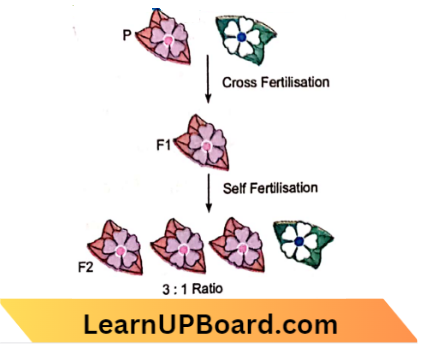
Dihybrid Cross: It is a cross between two individuals for studying the inheritance of traits of two different characters. Mendel crossed a pure breeding round green-seeded (RRyy) plant with the pure breeding wrinkled yellow-seeded plant (RR).
F1 plants or hybrids were all round and yellow-seeded (RrYy). On self-breeding the F1 plants Mendel obtained four types of plants—round yellow (315/556 or 9/16), round green (108/556 or 3/16), wrinkled yellow (101/556 or 3/16) and wrinkled green (32/556 or 1/16).
Here, round yellow and wrinkled green are new combinations of traits. This is possible only if there is an independent assortment of traits of the two characters. The ratio is called the dihybrid ratio.
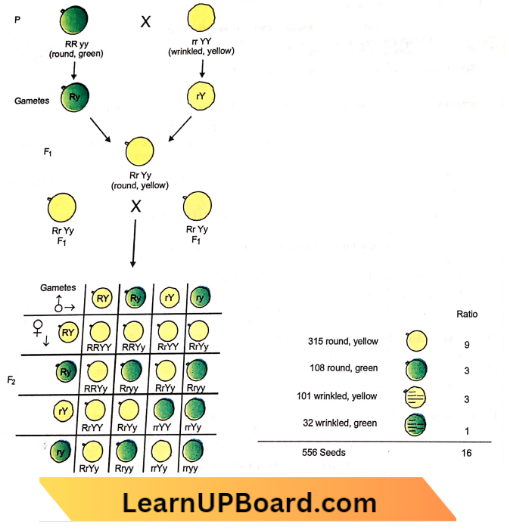
Important Terms :
Character: It is a distinct feature of an organism like the flower colour, or height of a plant.
Trait: It is the alternate expression of a character, for example, tallness for height.
Gene: It is a linear segment of DNA or chromosome that functions as a unit of inheritance.
Alleles: Genes occurring in homologous chromosomes at the same locus are called alleles or allelomorphic pairs.
Being particulate they are also called factors or units ofinheritance. They may express the same trait or different traits of character, for example, TT, Tt, tt, RR, Rr, rr. Here, the capital letter represents the dominant factor (T for tallness) while the small letter signifies the recessive factor (t for dwartness).
class 10 chapter heredity and evolution notes
Homozygous: It is an organism with identical alleles, for Example, TT, RR, r r, 1 1. Homozygous individuals are generally genetically purebred.
Heterozygous: It is an organism which possesses contrasting (both dominant and recessive) traits of character, Example Tt, Rr.
Dominant Factor: It is an allele or factor that expresses its effect in both homozygous and heterozygous states, Example TT, Tt.
Recessive Factor: It is an allele or factor that is unable to express its effect in the heterozygous state. Recessive factor expresses its effect only in the homozygous state, Example tt.
Differences Between Dominant And Recessive Factors
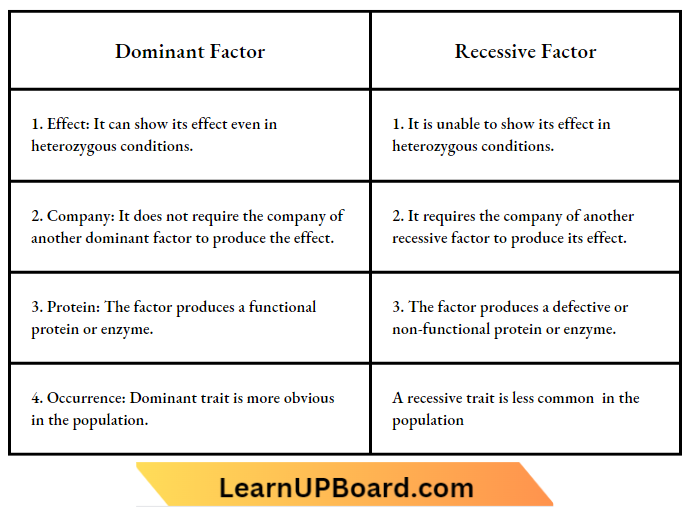
F1 Generation (First Filial Generation). It is a generation of hybrids that are formed from a cross between two genetically different pure-breeding individuals.
F2 Generation (Second Filial Generation). It is a generation that is formed through inbreeding amongst members of the Fj generation.
True Breeding (Pure Line): It is a lineage of homozygous or genetically pure individuals that produce similar genetically pure offspring.
heredity in science
Monohybrid Ratio: The ratio of types of individuals produced in the F2 generation, when the inheritance of a single character is studied, is called the monohybrid ratio. The phenotypic ratio is 3: 1 while the genotypic ratio is 1 : 2: 1.
Dihybrid Ratio: The ratio of types of individuals produced in F2 generation when the inheritance of two characters is studied is called the dihybrid ratio. Its phenotypic ratio is 9: 3 : 3: 1 while the genotypic ratio is 1: 2: 2: 4: 1: 2: 1: 2: 1.
Phenotype: It is the morphologically expressed character of an individual, for Example round seeded, wrinkled seeded. the In case of a recessive trait, the phenotype and genotype are the same. In the case of a dominant trait, the phenotype is genetically of two types, pure (Homozygous) and hybrid (Heterozygous).
Genotype: It is the genetic complement of an individual about one or more characters whether or not their factors find expression in the phenotype. example the le, genotype of tall pea plants can be TT or Tt. In Tt, the factors for tallness (T) find expression while the factor for dwarfhess remains (t) unexpressed.
Differences Between Phenotype And Genotype
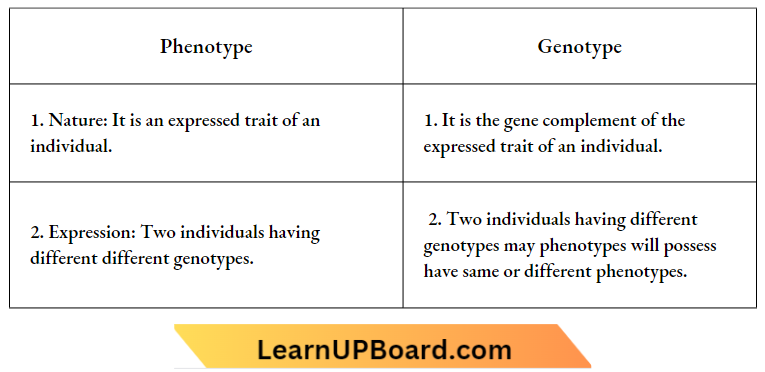
Mentalism
(Mendel’s Laws of Inheritance)
Principles or laws of inheritance as discovered by Mendel (1866) are collectively called Mendelism. They are three in number —the law of dominance, the law of segregation and the law of independent assortment.
Law of Dominance: Out of the two alleles or factors in hybrid, | Parents| only one expresses its effect. The other allele remains unexpressed. The allele which finds expression in the hybrid is called the dominant allele or factor while the unexpressed allele is known as the recessive allele or factor.
- The dominant allele is designated by a capital (Example T) letter while the recessive allele is designated by a small letter (t) of the alphabet.
- Cross a pure tall (TT) plant of Pea with a pure dwarf (tt) plant. Fj plants are all tall though they have also received an allele for dwarfness.
- This shows that the factor or allele of tallness is dominant over the allele of dwarfness.
genetics and evolution
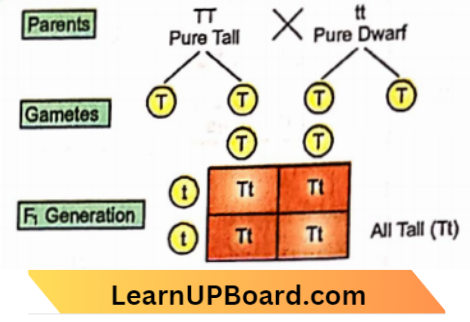
Law of Segregation: The two alleles or factors of a character particulate entities which remain distinct in an individual whether or not any of them expresses its effect. Both the factors separate or segregate at the time of gamete formation. A gamete receives only one of the two factors for the character. It is, therefore, always pure. The law of segregation is, therefore, also known as the law of purity of gametes. The double nature of factors is restored after fertilization.
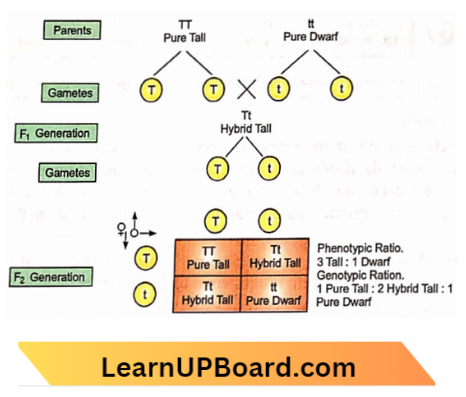
Select pure tall (TT) and pure dwarf (tt) Peas plants as parents. Cross the two. The hybrid or plants of the F1 generation are all tall despite their having received a factor for dwarfness as well.
F1 plants are allowed to self-breed and produce F2 generation. In the F2 generation, both tall and dwarf plants appear in the ratio of 3: 1. It is possible only if the factor for dwarfness was present in the F1 generation. It separates from the factor of tallness during the formation of gametes. On fusion of two gametes each carrying the factor for dwarfness will produce an offspring with the recessive character of dwarfness.
Law of Independent Assortment: The two factors or alleles of a character separate independent of factors of another character at the time of gametogenesis. They also come together independently of one another during fertilization. As a result of independent assortment, fertilization produces a new combination of traits or factors. They are called recombinations.
Select pure-breeding tall round-seeded and pure-breeding dwarf wrinkled-seeded Pea plants as parents. Cross the two. Plants of the F1 generation or hybrids are all tall and round-seeded because of the dominant nature of alleles of tallness and round-seededness. Raise F2 generation by allowing the F1 plants to self-breed.
genetics heredity
F2 generation has four types of plants-tall and round seeded (9/16), tall and wrinkled seeded, (3/16), dwarf and round seeded (3/16) and dwarf and wrinkled seeded (1/16). Only two of these (tall rounded and dwarf wrinkled) are parental types. The other two types (tall wrinkled and dwarf rounded) are new combinations. New combinations can appear only if the factors for the two characters separate and come together independently of one another.
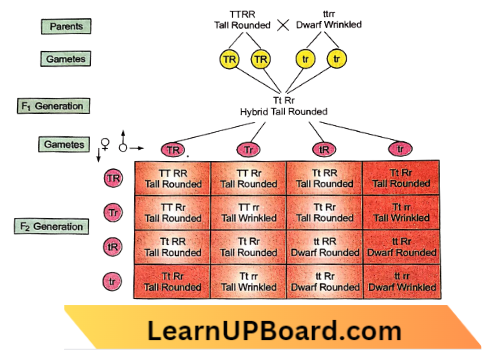
Contribution By The Parents
Each parent has two sets of genes or chromosomes. A gamete receives only one set of genes or chromosomes. When the gametes fuse during fertilization, the double set or diploid number of genes or chromosomes is restored.
Therefore, in sexual reproduction, each parent contributes half of the genetic material. Thus, both parents contribute equally. Of course, there is reshuffling of chromosomes during gametogenesis and fertilization that results in variations and independent assortment.
In asexual reproduction, there is no halving of genetic material, nor doubling of halved material. Instead, the full gene complement or genetic material of the parent is transferred to the daughters through mitotic divisions.
UP Board Class 10 Biology Notes For Heredity How Do The Traits Get Expressed
How does the mechanism of cellular DNA (gene) work in the production of hormone enzymes?
Traits are morphological or physiological expressions of factors or genes. Genes are segments of DNA. They operate through the formation of wRNA which then forms structural or enzymatic proteins. A dominant factor produces a fully functional protein.
- A recessive factor does not form a fully functional protein. Therefore, while a dominant factor can express its effect even in the heterozygous state, a recessive factor cannot do so. It shows its effect only when it is present in the homozygous state.
- The character of height in Pea is controlled by growth hormones. They are synthesized through enzymes produced by proteins formed by growth factors. The dominant factor for tallness (T) synthesises a protein that efficiently gives rise to growth hormones.
- Therefore, the plant becomes tall. In the case of the recessive factor for dwarfness (t) less efficient protein is formed when it is present in the homozygous state. As a result growth hormones are formed and the plant remains dwarfed.
UP Board Class 10 Biology Notes For Heredity Sex Determination
How is the sex of a newborn individual determined? Does it depend on the inheritance of X and Y chromosomes?
Sex determination is the establishment of maleness and femaleness of the individuals through the formation of their sex organs. In some animals, sex is determined environmentally while in the majority of animals and humans, it is controlled genetically.
In turtle Chrysema picta, females are formed if the eggs are incubated at a temperature of about 33°C. A temperature below 28°C forms male animals.
In the lizard Agama agama, males are formed at higher temperatures.
Annelid Ophryotrocha changes sex from male to female as it grows old. Similar sex changes also occur in some snails.
Sex Determination in Humans: Genetic control of sex determination is carried out by chromosomes. There are two types of chromosomes, autosomes and allosomes.
Autosomes control various functions of the body other than sex. Allosomes (=heterosomes) determine sex along with other functions. They are called sex chromosomes.
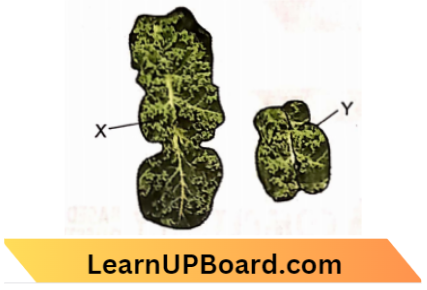
Human beings possess 23 pairs of chromosomes. 22 pairs are autosomes. One pair of chromosomes are sex chromosomes or allosomes. The two allosomes are similar in females.
They are XX chromosomes. The two allosomes of males are different. One is X-chromosome while the other is smaller and called Y-chromosome.
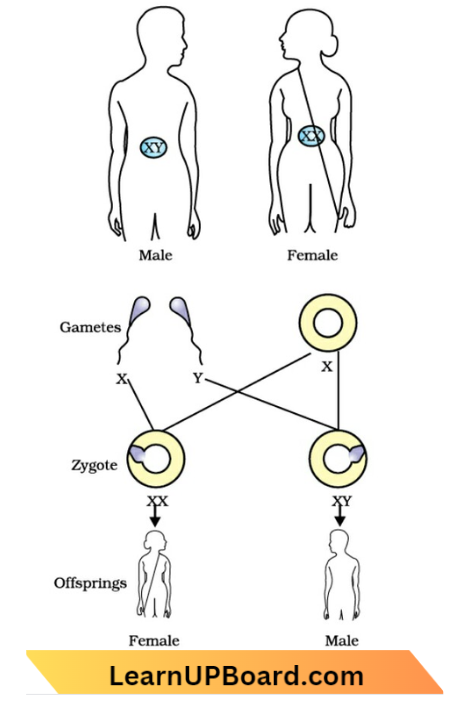
Human Females are 44 + XX while human males are 44 + XY. Because of the similar nature of X-chromosomes the sex chromosomes of females are called homomorphic. They are heteromorphic m males. The Emma endosperm forms one type of egg, 22 + X.
The males are heterogametic. They form two types of sperm, (22 + Y) and gymnosperms (22 + X). The two types of sperms are produced in equal numbers.
1 n + x and 22 + Y chance factor which depends upon whether an angiosperm fuse with the egg and forms male is 50: 50 or 44 + XY) or a gymnosperm fuse with the egg to produce a female baby (22 + X and 22 + X or 44 )ÿ chance of the birth of a boy or girl.
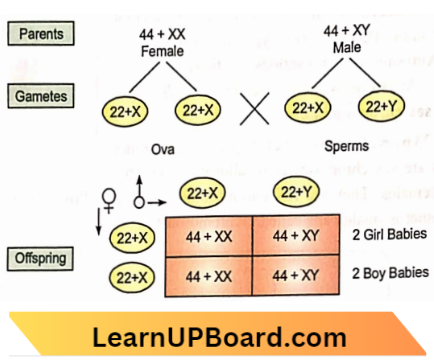
UP Board Class 10 Biology Notes For Heredity Questions And Answers
Question 1. How do Mendel’s experiments show that traits may be dominant or recessive?
Answer:
Mendel’s crosses between plants having visible contrasting traits proved that traits may be dominant or recessive. He crossed a pure tall Pea plant with a pure dwarf Pea plant.
- All the plants of the F1 generation were tall and none J with medium height or dwarfnature.
- On self-breeding of F1 plants, Mendel obtained two types of plants, tall: and dwarf in the ratio of 3: 1. It means that the factor of dwarfness was present in Fj plants.
- It did not express its effect because it is recessive while the factor for tallness is dominant as it can express its effect and suppress that of the factor for dwarfness.
Question 2. How do Mendel’s experiments show that traits are inherited independently?
Answer:
The traits of different characters are not linked. The traits of one character are inherited independently of the traits of, another character. Mendel performed a dihybrid cross between rounded green-seeded plants (RRyy) and wrinkled yellow-seeded plants (rrYY).
- In the F1 generation, he obtained round yellow-seeded plants. On self-breeding F1 plants, Mendel obtained a progeny of F2 generation of four types of plants—round yellow seeded (9/16), round green seeded (3/16), wrinkled yellow seeded (3/16) and wrinkled green seeded (1/16).
- In this progeny, there are two parental types and two new combinations or recombinations. Recombination of traits can occur only if they are inherited independently of one another.
Question 3. A man with blood group A marries a woman with blood group 0 and their daughter has blood group O. Is this information enough to tell you which of the traits, blood group A or O, is dominant? Why or why not?
Answer:
No, The appearance of a recessive trait can occur only when its factors are in the homozygous state. The appearance of a dominant trait can occur both in homozygous and heterozygous states.
- In this particular cross, both A and 0 blood groups can be dominant as well as recessive. Possibility 1. Blood group A is dominant. Father with blood group A can be I AIA or IA 1°. The mother with blood group 0 must be I°I°.
- The daughter can be genetically IAI° or I°I°, that is of blood group A or 0. Possibility 2. Blood group 0 is dominant. Mothers with blood group 0 can be I°I° or 1° IA. Father with blood A should be I I only. The daughter would be of blood group 0 or A.
Question 4. How is the sex of the child determined in human beings?
Answer:
The sex of the child is determined by the chromosome complement of the gametes that fuse during fertilization. In human beings, females are homogametic. They produce only one type of ova, i.e., 22 + X.
- Males are heterogametic. They produce two types of sperm, angiosperms with 22 + Y chromosome complement and gymnosperms with 22 + X chromosome complement Sex of the child will depend upon the type of sperm that fuses with the ovum.
- It will be male if fusion has occurred with endosperm (44 + XY) and female if fusion has occurred with a gymnosperm (44 + XX).
